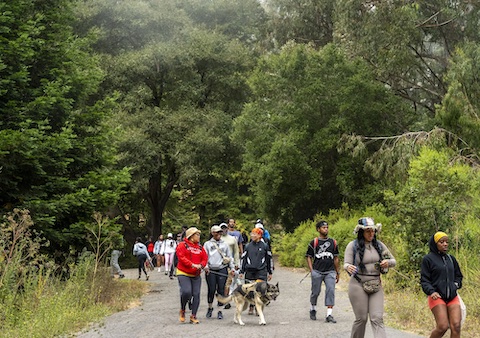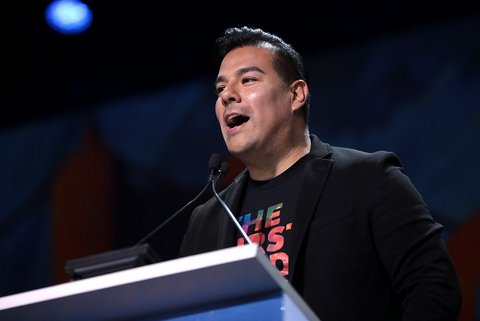
16 Oct Ahead of Great ShakeOut, State Provides Earthquake Preparedness Tips

Jose Lara, California Governor’s Office of Emergency Services seismic hazards branch chief, says bringing earthquake preparedness awareness to underserved communities is paramount. That website behind him is earthquake.ca.gov. (Screenshot captured by Joe Porrello / The CC Pulse)
By Joe Porrello
Drop, cover and hold on.
That was a key piece of advice from earthquake experts at a press teleconference hosted by Ethnic Media Services and California Black Media on Oct. 10.
Speakers from Listos California, which specializes in disaster readiness, and the California Governor’s Office of Emergency Services, are trying to increase state residents’ earthquake preparedness through education, resources and technology.
The annual Great ShakeOut — an international earthquake drill — urges people to collectively practice their readiness, no matter where they are or who they’re with. This year, it will be held Oct. 17, which happens to be the 35th anniversary of the 1989 Loma Prieta Earthquake, starting at 10:17 a.m. local time. It’s the largest drill of its kind, with 10.5 million Californians and over 57.4 million people worldwide registered to participate as of Wednesday.
>>>Read: BART Trains Will Slow, Stop as Part of ShakeOut Day Earthquake Drill<<<
According to the U.S. Geological Survey, there is a 72% chance of a 6.7 magnitude earthquake occurring in the San Francisco Bay Area during the next 30 years; in Los Angeles, 60%.
But Amy Palmer, Cal OES deputy director of crisis communications, says earthquakes are unpredictable.
“It really is hard, despite all the scientific advancements, for any scientist to reputably predict an earthquake,” she said.
One safety blanket is California’s first-in-the-nation Earthquake Early Warning System, made possible by Cal OES and UC Berkekley’s Seismology Lab managing ground sensors across the state that detect shaking. Through downloading the free MyShake app on Apple or Android — available in English, Spanish, Chinese, Vietnamese, Korean and Filipino — and turning on alerts in settings, users are given time to prepare before an earthquake starts.
“We’ll continue to save lives by getting critical information to people in the right ways… in the moments when they need it most,” said Palmer.
Cal OES seismic hazards branch chief Jose Lara noted that since the early warning system launched in 2019, recent government investment in additional sensors has led to more useful alerts.
“The speed with which the info is getting from the sensors in the land to the mobile phones in people’s hands is faster than ever before,” said Palmer. “Earlier this year, there were more than 20 seconds of warning for many people.”
With other disasters like wildfires and hurricanes at the forefront of societal consciousnesses, Palmer says earthquake preparedness cannot get lost in the shuffle.
>>>From Our Archives:
As Storms Subside, State Advises Preparation for Next Natural Disaster<<<
To draw awareness, Cal OES hosted the Great California ShakeOut Tour this month, with stops in San Diego, Los Angeles and Sacramento. Attendees are briefed on how to prepare and can experience an earthquake simulator with the ability to safely mimic 7.0-magnitude shaking.
“It makes you realize why it’s so important to know what to do,” Lara said.
According to the Earthquake Country Alliance, the seven steps of earthquake safety are:
- Secure your space by identifying hazards and movable items
- Create an emergency plan and way to communicate
- Organize emergency supplies in convenient locations
- Minimize financial hardship by organizing important documents, strengthening your property, and considering insurance coverage
- Drop, cover and hold on if you get an alert or feel shaking
- Evacuate or help the injured, if necessary
- Restore daily life and rebuild community by repairing damage and reuniting with others
Lara says securing one’s space is crucial. “You can experience injury by falling furniture or objects,” he said. “Secure your space, have a go-kit, make a plan.”
In the magnitude 6.7 1994 Northridge Earthquake, 55% of injuries were caused by falling items while 1% were due to building damage.
Sonya Harris, a senior advisor at Listos California, says preparing is usually easier and cheaper than people think — and lessens financial and physical hardship afterward, like that of 1989.
Loma Prieta, a magnitude 6.9 quake, resulted in billions of dollars in damage, 63 dead and 3,757 injured, as well as the destruction of 963 homes and 147 businesses.
“You may have lived through or seen some of the horrifying images of freeways and banks of homes collapsing,” said Lara.
People often freeze when an earthquake arises, according to Lara, which can be combated by practicing the “drop, cover, hold on” technique in all types of settings.
“Without that muscle memory, when shaking arrives at your location, you may not take that protection action you need to stay safe,” he said.
Raised in a region of Mexico without building codes, Lara said he was taught as a child to run outside if an earthquake began.
“That’s not the case in California… we expect that in most buildings, you’ll be able to survive with minimal injuries,” he said. “We want to encourage people to not run out of a building because we see oftentimes, most of the injuries that happen are from people attempting to do just that.”
The safest place to be is under a table, according to experts, who say to drop before shaking does it for you.
To officially participate and be counted in the Great ShakeOut, register at www.ShakeOut.org.
Lara says he expects the number of participants to grow by millions in the last days before the drill takes place.
“We want to get back to pre-COVID numbers, and we think that this is the year that we’re going to be able to surpass our largest count,” he said.
More disaster resources can be found in multiple languages at www.listoscalifornia.org.
Tens of millions of earthquake alerts sent out to Californians thus far is just the beginning of preparedness, says Lara.
“The future is whereby no one has to download an app to receive an alert… where it’s totally integrated into all our lives,” he said. Like fire alarms and stop, drop and roll.






No Comments